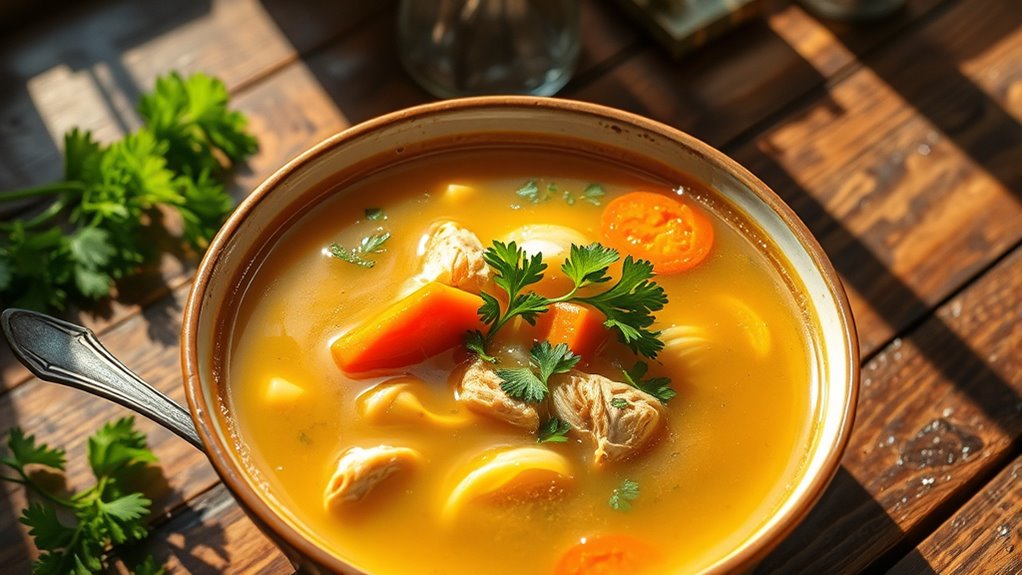This Chicken Soup for the Soul recipe starts with a fragrant, softly simmering broth that welcomes you the moment you lift the lid. You’ll know comfort as tender chicken joins carrots, celery, and onions, their aromas weaving through warm steam. Each spoonful feels soothing, a touch of garlic and bay leaf lifting the flavor. You’ll savor the gentle, nourishing finish that boosts energy and mood, with little leftover drama—and there’s more to discover beyond the surface.
Ingredients and Quantity
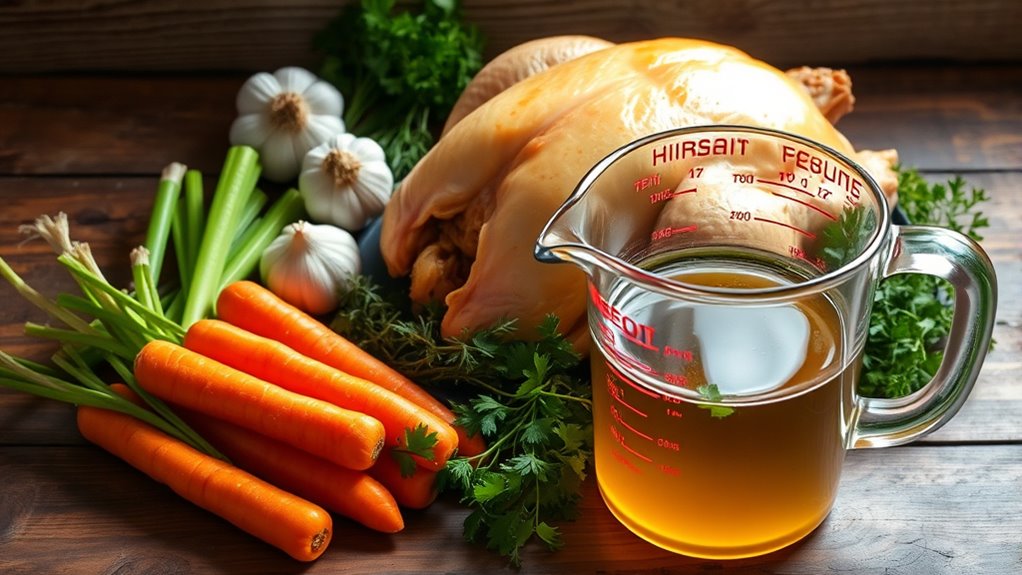
Here are common ingredients and quantities for a comforting chicken soup, written plainly so you can mix and match to taste: chicken (about 1 to 1.5 pounds of bone-in or boneless thighs or a mix), carrots (2 medium, sliced), celery (2 stalks, sliced), onion (1 medium, diced), garlic (2-3 cloves, minced), chicken bones or carcass for extra flavor (optional), salt (1 teaspoon, plus to taste), pepper (½ teaspoon), bay leaf (1), fresh parsley (a small handful, chopped), olive oil or butter (1-2 tablespoons), and water or chicken stock (6-8 cups).
| Ingredient | Quantity |
|---|---|
| Chicken | 1-1.5 lb |
| Vegetables | Carrots 2, Celery 2, Onion 1, Garlic 2-3 |
| Flavor | Salt 1 tsp, Pepper ½ tsp, Bay leaf 1, Parsley, Oil/Butter 1-2 tbsp, Water/Stock 6-8 cups |
Preparations
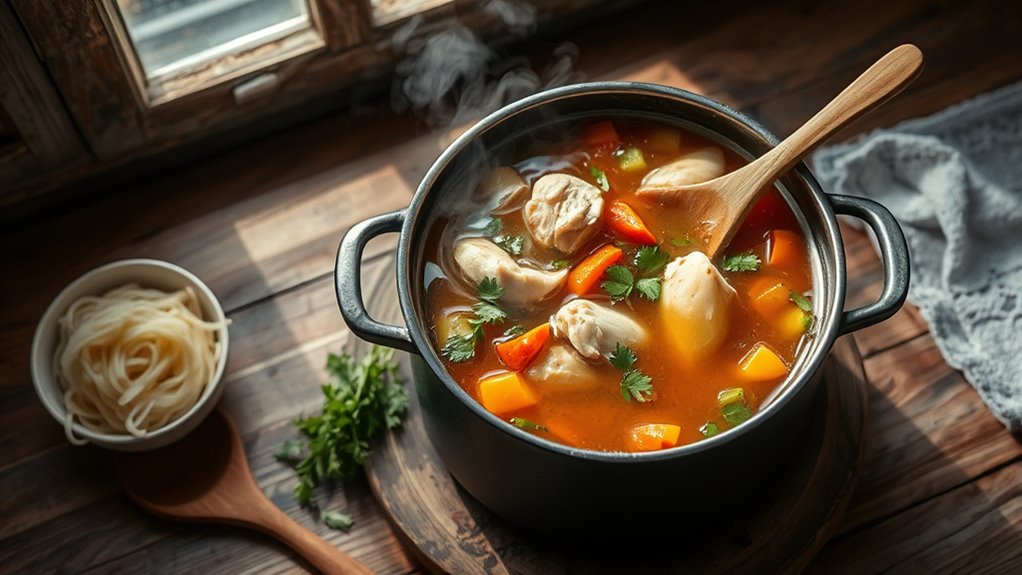
As you prep, rinse the chicken and pat it dry, so the surface moisture won’t dilute the flavor as it browns. You’ll trim excess fat and loosely season, letting salt draw out subtle juices that concentrate during simmering. Gather vegetables—carrots, celery, onions—and slice them to invite fragrance without overpowering the broth. There’s a quiet art to layering: a gentle sauté of aromatics first, then the chicken, and finally the water that becomes the soul of the soup. Throughout, stay mindful of meal prepping needs—portioning and timing so leftovers taste fresh. The goal is flavor enhancing without fuss, so every stir invites warmth. You’re shaping nourishment that sustains, with movement that feels free and purposeful.
Kitchen tools or Kitchenware Required
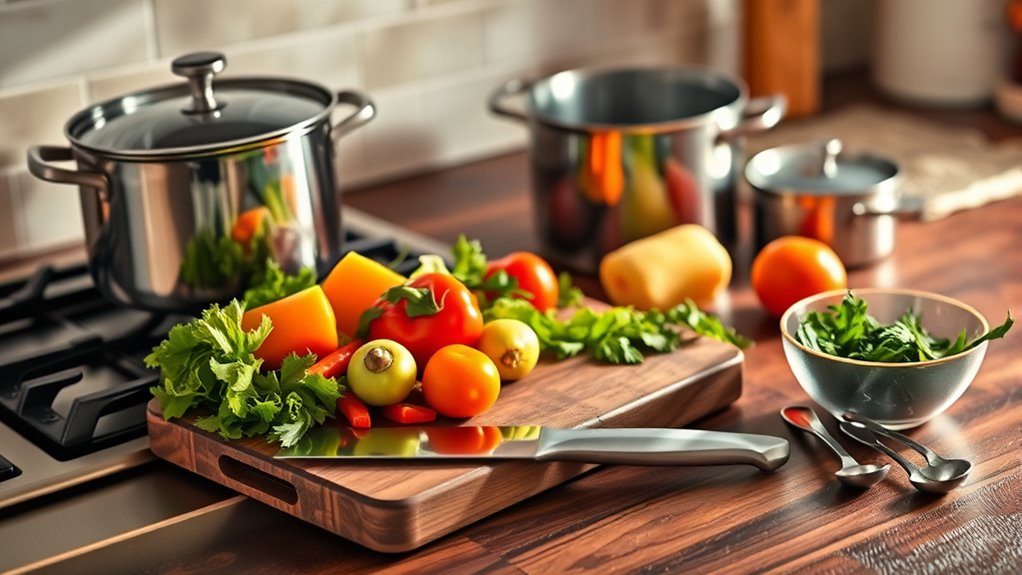
To make a soulful chicken soup, you’ll want a few dependable tools: a sturdy pot or Dutch oven with a lid, a sharp chef’s knife, a cutting board, a wide ladle, and a slotted spoon.
Kitchen gadgets and cooking utensils become your quiet allies, shaping every simmer and scent. With precision, you’ll reach for the pot, the knife’s precise edge, and the cutting board’s firm surface, letting freedom breathe as flavors bloom. A sturdy strainer or spider can lift tenderness without drama, while measuring spoons keep balance steady.
| Imagined tools | Sensory role |
|---|---|
| Pot, knife | Core rhythm |
| Ladle, spoon | Gentle guidance |
How to Cook
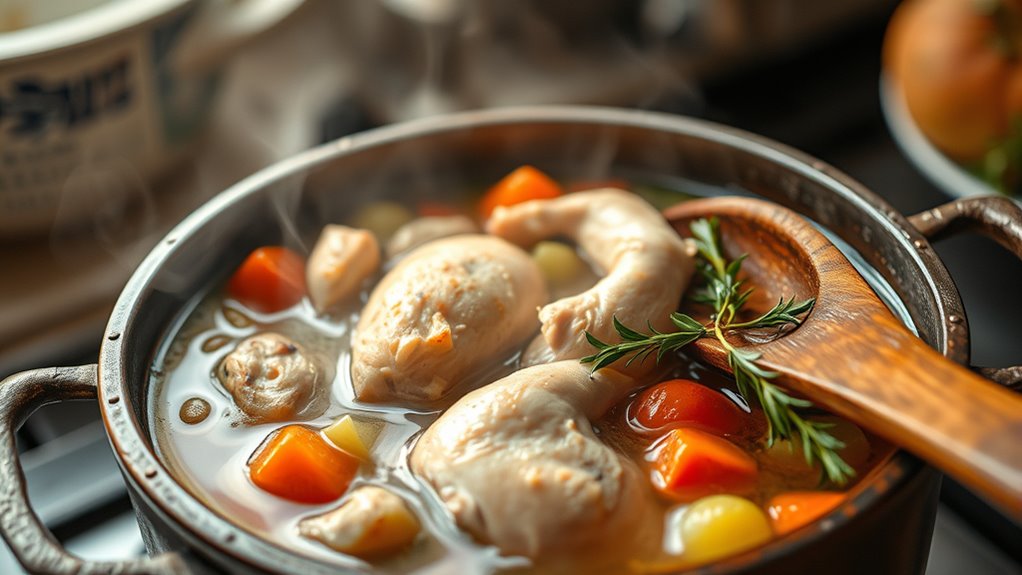
- Start by selecting simple, honest ingredients for your chicken soup.
- Place the ingredients in a pot and cover them with cold water.
- Bring the pot to a gentle simmer; avoid boiling hard to preserve delicate flavors.
- Season gradually, tasting often to adjust the broth’s depth and brightness.
- Skim foam from the surface with patient, steady strokes to keep the broth clear.
- Add aromatics such as herbs and vegetables to release fragrant flavors.
- Use cooking techniques that respect time: longer simmering for deeper flavors, shorter for fresher notes.
- Enhance flavor with small adjustments: salt, a splash of citrus, a herb bouquet, and a touch of pepper.
- Cook with intention and attention, allowing the soup to develop a comforting, nourishing glow.
How to Serve
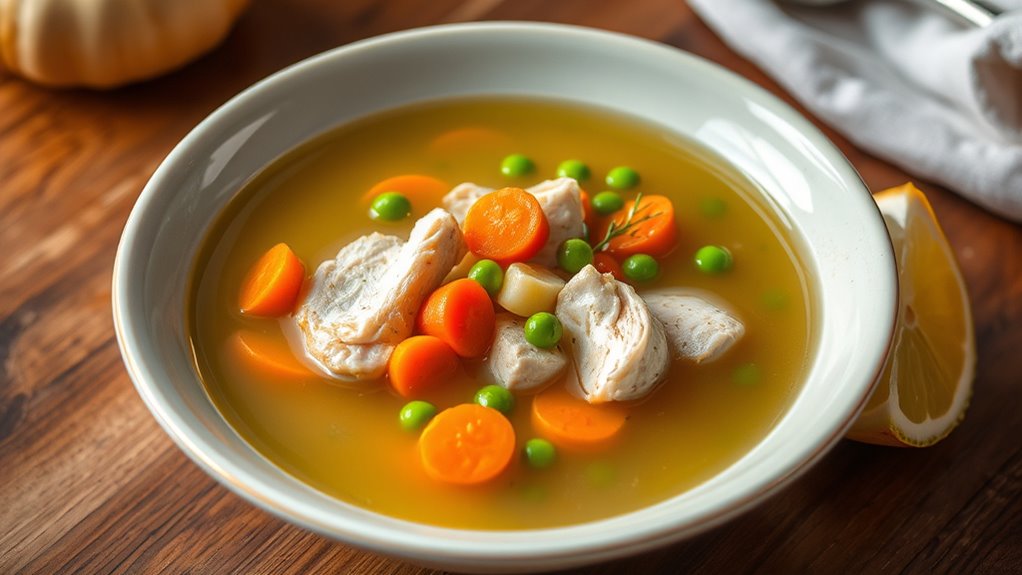
When you’re ready to serve, ladle the clear broth first to showcase its hue and scent, then add the tender chicken and vegetables in generous, balanced portions. You’ll notice steam curling above each bowl, the aroma inviting you to breathe deeply and savor the moment. For serving, use shallow bowls to highlight the broth’s clarity and color, and garnish with a kiss of fresh herbs for a bright finish. Presentation ideas include arranging vegetables in a rainbow arc, placing a lemon wedge beside the bowl, and wiping rims for a clean, restaurant-like look. Serving suggestions emphasize accessibility and warmth—gentle steam, steady steam, and a comforting, homey scent. Keep portions even, so everyone feels cared for and free.
Tips
A few practical tips can elevate your chicken soup from comforting to memorable: choose chicken with a little extra bone-in flavor for richer stock, skim the surface gently to keep the broth clear, and season gradually so you don’t oversalt. As you simmer, keep the pot fragrant but not boiling hard; a gentle, steady bubble preserves tenderness and aroma. Add aromatics in layers—onion, carrot, celery—so every sip carries memory, not just heat. Taste often, adjusting salt and pepper with care, so the final bowl feels balanced. Use leftovers to build comfort food moments that taste like home, and serve when family meals feel most needed. Your broth should whisper warmth, inviting conversation and connection.
Food Value and Benefit
Food Value and Benefit of Homemade Chicken Soup
This homemade chicken soup is a nourishing and wholesome dish packed with essential nutrients and health benefits. The broth is rich in minerals like calcium, magnesium, and phosphorus, as well as gelatin, which supports joint health and digestion. The tender vegetables contribute important vitamins such as vitamin A, vitamin C, and several B vitamins that help enhance focus and boost the immune system. The protein from the chicken provides sustained energy and muscle support without feeling heavy.
Benefits of Eating Homemade Chicken Soup:
- Supports joint health and improves digestion due to gelatin and minerals in the broth
- Boosts immune function with vitamins A and C from vegetables
- Enhances mental clarity and focus through B vitamins
- Provides sustained, light energy from lean protein in chicken
- Soothes throat discomfort and promotes relaxation with gentle warmth
- Encourages mindful eating and listening to your body’s needs
This simple, nutrient-rich soup delivers comfort and wellness through carefully selected ingredients, making it an ideal choice for both everyday nourishment and recovery during minor illnesses.
Frequently Asked Questions
Can I Substitute Chicken With Turkey or Tofu?
Where there’s a will, there’s a way.” Yes, you can substitute: Turkey benefits and Tofu texture adapt to soups. You’ll savor rich savoriness, flexibility, and freedom as you adjust seasoning, simmer time, and flavor to taste.
How Long Does It Keep in the Fridge?
You’ll get about 3 to 4 days in the fridge for soup, refrigerated properly. Shelf life matters, so check for off smells. Storage tips: store in airtight containers, reheat gently, and trust your senses to stay fresh.
Can I Freeze This Soup for Later?
Yes, you can freeze this soup for later. Picture a humming kitchen: you ladle, freeze in portions, label clearly. Freezing tips: cool completely, use airtight containers, and enjoy within 3 months; proper soup storage preserves flavor and texture.
What’s the Ideal Reheating Method Without Drying?
Yes—you reheat to keep it moist by using gentle heat. For Microwave tips: heat in 30–60 second bursts, stirring. For Stove reheating: warm slowly, add a splash of broth, cover, and simmer until steaming and fragrant.
Are There Gluten-Free or Dairy-Free Options?
Gluten alternatives and dairy substitutes rise like dawn, offering you kinder bowls. You’ll savor rich, comforting textures while staying free—filling, fragrant, and satisfying. You can nourish yourself without gluten or dairy, embracing liberty in every spoonful.
